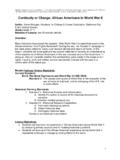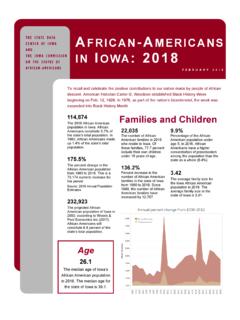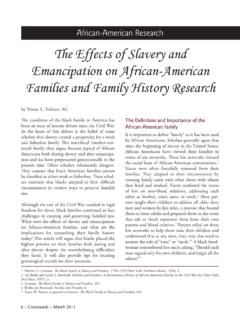Transcription of Why were African merchants willing to sell slaves …
1 Why were African merchants willing to sell slaves to Europeans? were they selling their own people ? Like most of the rest of the world, slavery was well-established in West Africa. It varied in texture, including caste or lineage slavery, military slavery, and especially labor slavery, as land was allocated according to need and ability to work the land. Some historians suggest that slavery in Africa was milder than the slavery that developed in North and South America, others argue that it was different but could be highly oppressive. Long-distance trading was an occupational specialty that West and West-Central Africans held in high regard. o The Atlantic hinterland of black Africa contained a grid of trade routes dotted with commercial settlements. These formed a network that permitted traders to travel widely among communities where they could employ local associates as their aids and agents.
2 O Trans-Saharan trading included a number of commodities, including slaves . o Europeans worked hard to furnish desirable trade commodities to African merchants o Revenues such as taxes and tolls kept African elites amenable to the enterprise. The majority of people sold to Europeans as slaves were prisoners of war, thus outsiders, and this was an acceptable fate for prisoners throughout most of the world. Africans did not identify on racial or national lines, but on very local levels and along lineage lines. They were not selling their own, any more than Europeans were purchasing their own. No African or Black identity in Africa during the slave trade. There was African resistance to the slave trade in various locations from time to time, but not frequent. Places in the Slave Trade: Liverpool: a sleepy fishing village in 1700, by 1800 it was a powerful commercial center because of slave trade and proximity to manufacturing regions in England.
3 Senegambia: an example of loosely organized trade; merchants mostly traded directly to Europeans along rivers. See material on Goree Island and Goree Warehouses in Liverpool Kingdom Dahomey: example of a militarized state that based its economy on slave trading with Europeans late in the history of the slave trade; King and his appointees controlled the trade. Kingdom of Kongo: earliest relationships with Portuguese were very respectful, early conversion to Christianity and then strong European control of the trade. Charleston: the Ellis Island for African Americans. Most Americans of African descent have ancestors who came through Charleston. Boston: not very many slaves in city, but it was deeply invested in the trade and in Rum production Chicago: Mississippi: French brought Senegambians there in early colonial era, then brought many Americans there during the Internal Slave Trade, 1820-1860.
4 Multi-media Resources: Africans in America 4-part video/DVD and web site for full text narratives of Africans for images of slave trade (also AIA above) lesson plans and overview of slave trade from MSU Teacher content knowledge development: Lindsay, Lisa (2008) Captives as Commodities: The Transatlantic Slave Trade Thomas, Hugh (1997) The slave trade : the story of the Atlantic slave trade, 1440-1870 Klein, Herbert (1999) The Atlantic Slave Trade Diouf, Sylvaine A. (1998) Servants of Allah: African Muslims Enslaved in the Americas Wright, Donald (2000), African Americans in the Colonial Era: From African Origins through the American Revolution, 2nd ed., Harlan Davidson Pub. Hine, Hine, & Harrold, The African -American Odyssey, Pearson Education, Inc. (Prentice Hall) 2006 reviews books on Africa for k-12 readers









